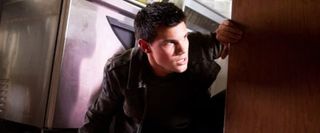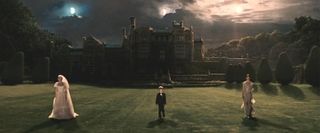
It's hard to get through any movie without someone biting the bullet-- whether the presumably countless victims of alien warfare in Green Lantern or Transformers: Dark of the Moon or the kinds of single deaths that spur heroes into action, like the dad's death in The Green Hornet or the good doctor Stanley Tucci getting shot by Nazis in Captain America: The First Avenger. But there's a difference between a death used to move the story forward and a death that really matters, something you remember long after the movie is finished, something you might even tear up about years later. We think we've picked out ten of those below, movie deaths that thrilled us, scared us, or got us a little emotional-- or maybe all of the above. Check out our picks below, let us know any we might have missed in the comments, and of course, rest in peace to all of the departed.

Harry Potter and the Deathly Hallows: Part 2
The Boy Who Lived had to die. While staring down his nemesis, Lord Voldemort (Ralph Fiennes), iconic wizard Harry Potter (Daniel Radcliffe) realizes that he’s the final Horcrux, the key to the Dark Lord’s demise. To fulfill the prophecy – “Neither can live while the other survives” – Harry has to die by his mortal enemy’s hand. And even though those of us who read J.K. Rowling’s text know it’s coming, the loss still hits with the impact of a killing curse. The eighth and final installment in the masterful Harry Potter franchise is weighed down by death and despair. But it was Harry’s courageous act of self-sacrifice that ensured this story would live on for generations. And the fact that Harry, ensconced in the glowing comfort of Kings Cross, chooses to return to the living and fight for his life only justifies the power of his earlier decision. It’s a memorable death for the magical life it later inspires … and continues to inspire in readers and moviegoers around the world.

Beth Emhoff
Contagion
CINEMABLEND NEWSLETTER
Your Daily Blend of Entertainment News
Unexpected deaths are terrifying. Certain characters who put themselves in harm’s way aren’t surprised when they’re bumped off. If a member of Sylvester Stallone’s Expendables team eats a bullet, his steroid-enhanced compatriots (and those of us sitting in the theater watching) shrug it off without a second thought. But when a suburban wife and mother like Beth Emhoff (Gwyneth Paltrow) bites the dust in Steven Soderbergh’s Contagion, we sit up and take notice because, hey, that could be us. Plus, it all happens so fast. It starts with an innocent cough. It escalates at a dizzying speed. Blurred vision. Wooziness. Numbness in your limbs. Convulsions. Death. For Soderbergh, Beth’s demise is the beginning of what ends up being a global pandemic. Paltrow’s gruesome death unnerves because like her husband (Matt Damon), we never see it coming.

Christina Warren
Source Code
Imagine knowing that a loved one is going to die in an explosion. You are given a chance to save them, but you fail – again and again and again. Welcome to the hell that is Jake Gyllenhaal’s life. In Duncan Jones’ Source Code, Gyllenhaal plays a combat veteran enrolled in an experimental military program that allows him to revisit the scene of a train bombing in the minutes before the explosive device detonates. His mission? Identify the bomber. But like any red-blooded American man, he finds himself falling for Michelle Monaghan’s beautiful Christina Warren, a passenger on the train, instead. Hard to fault him. Like a lethal Groundhog’s Day, Source Code keeps replaying Gyllenhaal’s failures, blowing Monaghan and her fellow commuters to bits over and over. Each time is a little bit different, but the results are always the same. And always final.

Unnamed elevator assassin
Drive
The elevator scene in Drive isn’t phenomenal just because of its incredible brutality, but because of contrasting passions felt by Ryan Gosling’s unnamed character. Realizing that the man in the elevator with him and Irene (Carey Mulligan) is there to kill them, the driver brings his love to the back corner and while the lights dim and time slows down he kisses her, knowing that he may never get the opportunity to do it again. Once he has left her embrace all of that love turns to indescribable rage as the driver successfully gets the gunman to the ground and proceeds to bash the guy’s skull in with his boot. The scene ends with Irene horrified by driver’s actions. It’s a game-changing moment both in the story and between the characters as our real hero reveals the monster within him, and it is extraordinary.

"There's a bomb in the oven" guy
Abduction
I don’t think I’ll ever truly understand exactly what the unnamed intruder in John Singleton’s Abduction meant when he said, “I’m not dying here, there’s a bomb in the oven.” The line is uttered while the man is being beaten with a fireplace poker, and after he says it Taylor Lautner heads over to the kitchen and discovers that said bomb will blow up in less than 10 seconds. So why did the guy tell Lautner about the bomb? Likely knowing how much time was left on the counter, why was he convinced that he wouldn’t be dying in the house? Most importantly, why did he plant the fucking bomb in the first place? The number of borderline retarded things done and said in Abduction is innumerable, but this moment is not only towards the top of the list, but also gives us one of the best death scenes of the year.

Bill Haydon
Tinker Tailor Soldier Spy
Tomas Alfredson's adaptation of John LeCarre's seminal espionage thriller Tinker Tailor Soldier Spy rarely gets emotional. It could be called dry, dense, layered and complex but few have found it affecting. But once you wade through the subterfuge and the red herrings you realize that there are many genuine relationships at the Circus and the film's central betrayal is not only against 'Crown and Country' but also against at least one dear, dear friend. The events that double-agent/mole Bill 'Tailor' Haydon (Colin Firth) set in motion result in the apparent death of his closest friend, field agent Jim Predeaux (Mark Strong). After learning of the deception, a long retired Prideaux sneaks close enough to the traitor's holding cell to get a good shot. Perfect aim. Right through Haydon's cheek. A tear runs down the face of Prideaux. All accounts are settled at the Circus.

Taxi passenger and driver
I Saw The Devil
When a sadistic killer of women and children, Kyung-chul (Oldboy's Min-sik Choi), chooses the the fiance of a highly trained special agent, Soo-hyun (G.I. Joe's Byung-hun Lee), as his latest victim he sets off a chain of events that not even his warped mind could have imagined. In what I call a 'rinse-repeat-revenge' flick director Jee-woon Kim (The Good, The Bad and The Weird) films a cat and mouse game for keeps unlike any other seen on screen. Everytime Soo-hyun apprehends his man, he tortures him brutally (achilles cut!) before releasing him in order to do it all over again. On one such release, our killer finds himself in a Taxi with a few suspicious characters and before they get the jump on him, Kyung-chul unsheathes his knife and stab furiously - all while the camera swirls around them both inside and outside the moving car until it crashes. It's visually stunning, viscerally intense and, well, just downright vicious.

Severus Snape
Harry Potter and the Deathly Hallows: Part 2
The tragic death of Severus Snape and the pensieve-memories that followed may have been the most well executed sequence of scenes in the final installment of the Harry Potter films. Snape’s sudden departure from the story comes at the hands - or rather, the snake - of the master he’d been pretending to serve for years. The death is fast, violent and mostly concealed from view, giving us just a hint of the harshness of his demise. While taking his dying breaths, Snape offers some of his most precious memories to Harry and asks only to look at his eyes, which so closely resemble those of the woman he’d loved most of his life, as he died. The pensieve scenes, which include some outstanding moments on the part of Alan Rickman, add context to Snape’s death as we learn his love for Lily Potter and his willingness to betray Voldemort and protect Harry for her long after she died.

The entire planet
Melancholia
The world ends twice in Lars von Trier's new film, once in a stylized kind of overture, in which we see slow motion scenes of the oddities that come right before the end, and again in the film's finale, with Justine (Kirsten Dunst), Claire (Charlotte Gainsbourg) and young Leo (Cameron Spurr) shielding themselves in a childish tent from the collision of two enormous planets. Only the second half of Melancholia is devoted to the impending apocalypse, but the lingering feeling of inevitable death defines the film, allowing for both the spectacular sight of a giant planet coming within Earth's orbit and then the world-ending explosion at the end. Nobody makes it out of Melancholia alive, but boy is it a spectacular and strange way to go.

The charging British cavalry
War Horse
We don't spend a lot of time with these ambitious and optimistic British soldiers, since War Horse isn't the story of the victims of war, but the miraculous horse who outlives all of them. But as played by Tom Hiddleston, Benedict Cumberbatch, Patrick Kennedy and a bunch of other strong-jawed Brits, the cavalry is rambunctious but also respectful and, most of all, convinced they will fight to glory on the battlefield. Instead they charge their horses, swords drawn, into the woods where machine guns wait for the ambush, gunning them down without hesitation. Soldiers know when they got into battle that death is a possibility, but seeing these fresh-faced young men slapped with the reality of modern warfare is heartbreaking, especially in that long shot of the riderless horses running through the woods. Spielberg may be aiming War Horse toward families, but that's once scene that pulls no punches.
For more of our end-of-the-year coverage, visit our Best of 2011 page.
Most Popular






